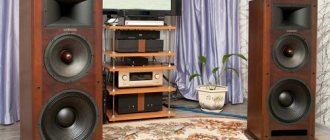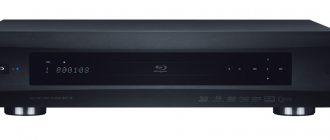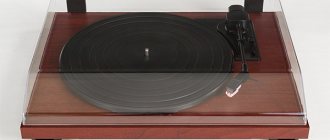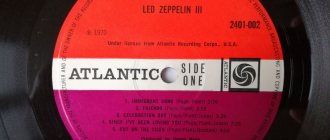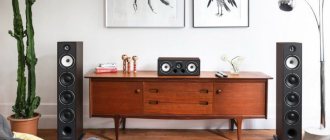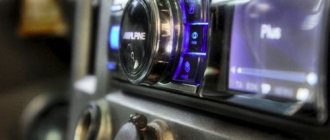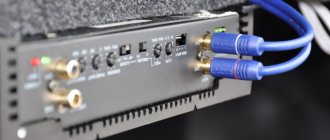Magnificent, figured and dense bass, compactness, high-level connection.
Proper placement is necessary for small rooms.
Specifications
| Rated power | 300 W |
| Frequency range | 28 Hz (-6 dB) - n/a |
| Adjustable crossover range | n/a |
| Dimensions (WxHxD) | 330 x 375 x 375 mm |
| Weight | 17.7 kg |
Technical commentary (S.P.)
When asked about the best British subwoofer manufacturer, REL is the first brand that comes to mind. For many years the company has been dealing with active bass players, and only them. Products, as a rule, serve as standards in their classes, but also stand up to their merits. By REL standards, this model can be called budget without any sarcasm.
The first thing that catches your eye is that the developers have finally thought seriously about design. Gone are the days when younger models were designed in the spirit of industrial electrical appliances; gloss a la “Apple” is in use here. There are two finishing options - black and white. In addition to the standard low-level RCA inputs, there is a port with a Speakon connector.
This is actually a proprietary way to receive a signal from systems where a special subwoofer output is not provided. The kit includes a cable (long enough) to connect directly to the stereo amplifier terminals.
By the way, Rel engineers recommend connecting the subwoofer specifically to the amplifier outputs, since this, in their opinion, allows you to “merge” the range of the subwoofer and front speakers and provide deep bass in all modes.
Volume, cutoff frequency and phase controls are traditionally located at the rear, and power management is automatic.
The design features a high-quality class A/B amplifier with a power of 300W and the presence of a passive radiator. The main, active speaker has a diameter of 254 mm and is directed towards the floor. An additional one, of the same diameter, is located on the front side. This option simultaneously helps reduce internal resonances and provides additional bass depth.
In practice, the device has clearly proven the advantages of the technologies used. Absolutely no parasitic overtones and truly three-dimensional, collected and tangible bass. The best result in the test and a clear recommendation for purchase. For a typical room in a city apartment, you shouldn’t look for other options. The only clarification is that to achieve the best result, the placement of the subwoofer should be taken seriously, taking into account the acoustic properties of the room.
REL: when the bass sounds and does not rumble, article. Magazine "Stereo & Video"
A subwoofer in a home theater today is more than just another channel. The sub is responsible for ensuring that low frequencies are sufficient even for those who like “chest hits”. A good sub makes the music richer and fuller. This is exactly what REL has succeeded in - it specializes exclusively in the production of subwoofers in different price ranges, different in appearance and installation features. The main thing is that they are of high quality in all aspects.
Save and read later -
Companies that specialize in a narrow segment tend to produce much better quality products than those that produce different types of devices. And this is logical - concentrating on one thing allows you to polish technologies to perfection and introduce unique developments. All this can be attributed to REL, a well-known manufacturer of subwoofers. And only subwoofers.
A subwoofer in a home theater today is more than just another channel. The sub is responsible for ensuring that low frequencies are sufficient even for those who like “chest hits”. A good sub makes the music richer and fuller. This is exactly what REL has succeeded in - it specializes exclusively in the production of subwoofers in different price ranges, different in appearance and installation features. The main thing is that they are of high quality in all aspects.
Not for “to be”
The story of the REL company is similar to many others: once upon a time there lived a talented man on Earth who did not like the situation on the market, and he decided to change it. In our case, this man's name was Richard Edmund Lord, and he did not like existing subwoofers and low-frequency solutions in multi-band acoustics. He made his fateful decision to change the world in 1990.
Transformers found in REL T series subwoofers
Richard was categorically not satisfied with the speakers that existed then, 25 years ago, on the market. He did not hear normal low frequencies in any acoustics: large speakers rumbled, and small ones simply squeaked. Subwoofers were nothing more than consumer goods for Richard, which were installed at home for “just what it was.”
Richard didn't like anything that was on sale at the time: he believed that low frequencies not only deserved their own separate cabinets in every sense, but deserved to be the best.
That's when he decided to create subs. He, without wasting any extra time, named the company REL (an abbreviation from the first letters of his own name - Richard Edmund Lord), coined the term “sub bass system” and began, rolling up his sleeves, to conquer audiophiles.
Audiophiles fell for the newcomer almost immediately - with the release of the REL Stadium model, a new chapter in the history of subwoofers was opened. Stadium was designed with Richard's guiding principle in mind: subs should fit into any system as naturally as possible and reproduce low frequencies as cleanly and clearly as possible.
| REL G-series subwoofer amplifier circuit |
The subwoofer should be physically present, but absent auditorily; a person should not hear that the subwoofer is playing right now. The system just needs to have good musical bass.
| REL G-series subwoofer speaker |
The first solution is that the woofer is connected to the bass amplifier with separate cables. Secondly, the subwoofer, according to Richard’s plan, becomes active and has its own independent, tunable crossover. In this case, the latter is completely separated from the system. An active circuit with a high input impedance was also invented, thanks to which the subwoofer was connected directly to the output terminals of the amplifier. After passing through the circuit, the signal enters the input of a power amplifier (with low output and high input impedance) using field-effect transistors, the parameters of which are optimized for operation with a low-frequency driver. By the way, all pass-through capacitors were excluded from this circuit.
Audiophiles appreciated all this and rushed to buy new products even more furiously, and in 1995 the company moved to the city of Bridgend in south Wales, simultaneously expanding the line in different price ranges. And the fact that REL produces only subwoofers gives the company an excellent chance to be head and shoulders above its competitors.
New era
In 2005, a new era for REL began with the acquisition of the company by John Hunter and Donald Brody. The new owners decided to “modernize” the company’s approach to product production. First, the current product lines have been updated externally to ensure the subs not only sound great, but look great, too. Secondly, we improved the electronics by replacing a number of components with better ones and “redrawing” some circuits. However, the basic principles are still practiced today. And reliability, innovation and modern design allow us to maintain leadership in the segment.
Subwoofer REL Habitat
Finished products are tested under the highest possible overload conditions, while the circuit boards themselves are manufactured to extremely strict standards to ensure the maximum degree of protection. Even cabinet joints are checked manually under bright light - they should not be visible, and the cabinets must be made extremely rigid so that no resonance spoils the sound quality. In addition, the cabinets use special tongue-and-groove joints combined with additional brackets that tighten the body to the maximum.
Richard Lord is no longer the director and chief designer of REL, but the company still produces high-quality low-frequency acoustics. He recently took a look at the new range of subwoofers for stereo and multi-channel systems and was very appreciative of what he called the "fantastic" job the new owners have done. Richard is still in close contact with the new owners and keeps his finger on the pulse.
Low frequency catalog
Today, REL products are represented by several lines of subwoofers. These are the S and T series, the Gibraltar series (aka G series), the Habitat wireless subwoofer and accessories. All of the company's subwoofers need to be calibrated during installation so that the bass fills the entire space, organically “merging” into the music, and does not come out only from one point. In addition, it is important to understand that these subwoofers are suitable not only for listening to music (including rhythmic music), but also for watching movies.
Inside the REL Gibraltar subwoofer
Finally, about connectivity. REL always recommends using a high-level connection for its subwoofers (directly to the amplifier's speaker terminals). For this purpose, a corresponding cable is included with the subwoofer, but you can also purchase an improved version of it separately.
Cable REL Bassline Blue
It should also be said that all models are equipped with a tunable crossover (with sixteen frequency values from 30 to 120 Hz), a phase switch, level controls, terminals for connecting a pre-amplifier output and outputs for connecting satellites with a low-pass filter. And the Set-Safe electronic circuit, which protects the subwoofer from overload.
Bass roll call
We will begin our journey through the REL line with the Habitat 1 subwoofer: it intrigues with its purpose, and its shape completely surprises. This subwoofer is quite thin at 11cm and can be placed directly on the wall (but keep in mind it weighs 23kg).
Inside the unusual device there are two woofers with a diameter of 17 cm and one 25 cm passive radiator. The amplifier power is 150 watts. Habitat 1 comes with a Longbow transmitter, which enables wireless transmission of signals - in the plural, since in order to avoid splitting the stereo signal into several ranges, REL recommends connecting the subwoofer simultaneously to both the outputs on the front speakers and the preamplifier output on the receiver.
The T series, produced in black and white cabinets, is the most popular due to its affordable cost. A small subwoofer called T-Zero (about 20 thousand rubles), with which the line begins, can be afforded by almost anyone.
Subwoofer REL T-Zero
Despite its compact dimensions (the shape is a cube with a side of 25 cm), the power amplifier of a class D subwoofer produces up to 100 W, and a smooth frequency response is ensured starting from 30 Hz - not only in the official technical data, but also according to Stereo&Video measurements. It only has one 165mm long-throw driver, but as you can see, this is enough to bring good bass to the system.
Subwoofer REL T5
The rest of the T-Series subwoofers are more powerful than the T-Zero and even more advanced, but the price remains affordable. Models T5, T7 and T9 differ among themselves in power and slight improvements in technical characteristics. These models have class A/B amplifiers. The older T7 and T9 already have two speakers (active and passive with diameters of 8 and 10 inches, respectively).
Since the R series has been discontinued and replaced in the same mid-range price range by the S series, this is what we will now turn our attention to. The line is represented by models S2, S3 and S5, and the increase in both power and the size and weight of subwoofers goes higher and higher from model to model - starting from 250 Watts for the REL S2.
Subwoofer REL S/2 (left) and S/5 (rear view and front without grill)
The models have separate volume controls, class D amplifiers and a built-in Longbow wireless receiver, which will allow you to do without extra cables (if the supplied ones are also considered such). And in the same way, the colors of the subwoofer cabinets are white and black.
REL G1 subwoofer remote control
And the most advanced from all points of view are the subwoofers of the Gibraltar series (aka G series). The line includes the top models G1 and G2. Both subwoofers can be controlled using a remote control, made in the original all-metal aluminum round housing.
Subwoofer REL G1
Model G2 itself. There's a massive heatsink on the back, a Class A/B amplifier, a four-layer high-power coil capable of dissipating up to 500W of power, and the body is coated with 13 layers of black lacquer.
Subwoofers REL G1 (left) and REL G2 (right)
In this case, no one will have enough bass. Moreover, the G series subwoofers can be organized into racks: the devices are placed on top of each other using special “rails”, and this creates massive racks of three models standing on top of each other. This is applicable mainly for large rooms: for example, each front speaker has a rack with three Gibraltars.
Prepared based on materials from the magazine “Stereo & Video”, May 2014
www.stereo.ru
This article was read 15,932 times
The article is included in the sections:
Hi-Fi manufacturers. Stories and interviews
Sound (A.V.)
This subwoofer works well in the lowest register and accurately reproduces the sound of instruments whose range extends to the lower end of the range (timpani, bass drum of a symphony orchestra). But individual notes do not sound quite uniformly and are somewhat harsh; apparently, there are problems with resonances.
But the subwoofer has high sensitivity, since it conveys well the changes in dynamics at the bottom, for example, crescendo and diminution to bass instruments.
43,500 rubles
All yours
The description of the Airmotiv T-Zero states that the speakers are designed to work both with stereo components and as front speakers in a home theater. However, company representatives insisted that the reproduction of musical material is the strong point of the model, and it does not suit true music lovers to be distracted by vain viewing of videos.
The presented integrated amplifier and CD player of the same brand are optimally combined with speakers and form an attractively priced set
For listening, we were offered a kit assembled mainly from products of the same brand, where the characteristics of the components are optimally combined with each other. The Emotiva BasX TA-100 integrated amplifier with a built-in DAC on the AD1955 chip (which is deservedly considered one of the best “one-bit devices” from Analog Devices) was entrusted to drive the speakers.
The main sound source was an Emotiva BasX CD-100 CD player, it was connected to the RCA analog input and used its own “good old” and, in my opinion, very musical DAC CS4398. This CD player can also work as a high-quality transport, connecting to the TA-100 via coaxial or optical connectors, but this time we connected a Yamaha WXC-50 network player to the amplifier’s “optics” to play “hi-res” from a USB drive.
Academic approach
It is usually assumed that the reproduction of bass by acoustics of such a form factor is, to put it mildly, “compromised”, and therefore I immediately suggest the T-Zero to cope with the aggressive “rapcore” of “Take The Power Back” from Rage Against The Machine. In response, the speakers produced distinct, full-bodied “lows,” revealing both the pressure of the drum kit and the ominous voice of the bass guitar. A characteristic “punch” is felt, while the speakers do not push into the chest at all, but sensitively “sway” the eardrums. The composition sounds, although authentic, but not in the usual menacing way, but somewhat academically, and you perceive yourself not as a fan at a rock concert, but as a conservatory teacher on the artistic council committee: “pay attention, colleague, to the characteristic overtones in Zach de la Rocha’s vocals...” . But this feature will help you live peacefully with neighbors in a panel high-rise building without loss in volume and sound quality.
In a small room, you will have to take care that the speakers do not stand close to the wall
On “Believer” by Imagine Dragons, the speakers managed to convey rich, thick sound and low-frequency rhythm along with well-drawn vocals and transparent highs. Smokie's "Oh Carol" sounded bright and killer: clear elastic bass along with detailed instruments and voice encouraged me to tap my foot to the beat, although I was never a fan of the group. However, it is worth warning that true “bassheads” may be disappointed: the speakers do not have a lot of “bass”, but just enough to reliably convey the performer’s intent.
The folk-blues composition “Blackjack Heart” by American performer Karen Michelle Johnston, known as Michelle Shocked, pleased with the thick, viscous sound of the double bass, distinct touches of the drum kit sticks and well-developed vocals. And the romantic rock-blues piece “Love Will Keep Us Alive” from the Eagles sounded intimate and chamber, and, I would say, enveloping and cozy.
Swiss electronic engineers Yello presented an interesting and unusual presentation. Hard high frequencies, as part of the band's signature style, which on conventional speakers hit the ears with sharp hammers, were presented softly and cleanly in the T-Zero interpretation thanks to ribbon tweeters. The volume and support at the “bottoms” were preserved, and the compositions, without losing energy and pressure, acquired a bit of elegance.
The speakers added shades of sophistication and, oddly enough, soulfulness to the expression of the classic “Bolero” by Joseph Maurice Ravel. Brass and woodwind instruments were clearly distinguishable, and the overall sound was detailed and harmonious.
It is important to note that the perception of music when listening was influenced not only by the speakers, but also by the characteristic style of the sources with their DACs: the CD player played more smoothly and melodiously (and I personally liked it more), and the built-in amplifier chip tried to present the stream from the network player a little more colder and more analytical. And this seems to be an additional advantage of this setup, when you can choose the sound to suit the genre or mood, entrusting signal processing to one or another device.
